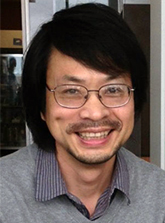Keynote Speakers
YOUR LOCATION : HOME > Annual Symposium > Keynote SpeakersKeynote Speakers

Sheng Yang He, Ph.D.
E-mail : Hes (at) msu.edu
Job title :
University Distinguished Professor, Departments: Plant Biology - Plant, Soil & Microbial Sciences - Microbiology & Molecular Genetics, Michigan State University
Investigator, Howard Hughes Medical Institute / Gordon and Betty Moore Foundation
Laboratory home page : http://www.thehelab.org/
Keynote Lecture
Toward understanding “Disease-Climate-Microbiome” triangles in plants
One of the most significant challenges of the 21st century is to discover innovative ways of increasing global crop production to meet the demands for food from the growing human population. A major roadblock to global food sufficiency is persistent loss of staple crops to pathogen infections. Greater efforts are needed to accelerate the buildup of a comprehensive knowledge base that explains how plant diseases occur; how plants defend against microbial pathogens; and how dynamic climate conditions impact plants, microbes, and their interactions. In 1960, RB Stevens (Plant Pathology, an Advanced Treatise. Vol. 3, Academic Press, New York) formulated the famous “Disease Triangle” concept, proposing that plant disease outbreaks require not only a susceptible plant and a virulent pathogen, but also conducive environmental conditions. For practical reasons, however, most contemporary investigations into plant-pathogen interactions at the molecular level devote little effort to understanding why climatic conditions, such as humidity and temperature, have a profound effect on pathogen virulence and host susceptibility. Moreover, these studies often ignore the potentially pervasive effect a plant’s endogenous microbiome may have on basic plant health and host-pathogen interactions. In this talk, I will give an example of interplays between disease, humidity and microbiota during Pseudomonas syringae infection of Arabidopsis thaliana leaves. Future studies of plant-pathogen interactions should increasingly consider the multi-dimensional nature of “disease-environment-microbiome” interactions that are more reflective of what occur in crop fields and natural ecosystems.

